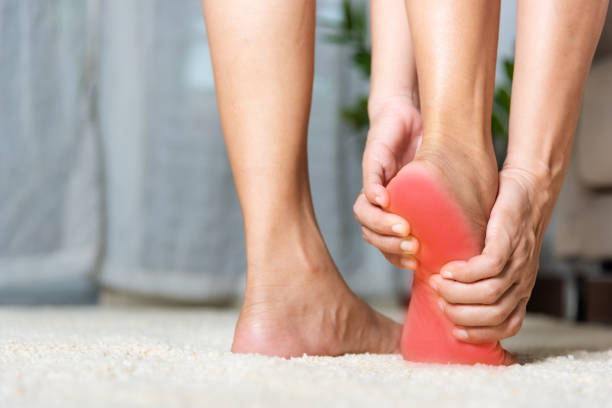Our feet take a beating, with 28 bones, 33 joints and over 100 muscles, tendons and ligaments working together to keep us moving. A podiatrist – sometimes called a chiropodist – is the specialist who treats these all-important structures.
A common foot injury is plantar fasciitis, a pain in the heel that affects anyone who overdoes it. Another is a neuroma, a painful nerve problem that strikes women who wear impractical high heels.

Treatment
Podiatrists can perform surgery on the foot and ankle to treat a variety of conditions. They can also prescribe medication, insoles or special shoes and can provide physical therapy to treat a wide range of problems, including ingrown toenails, pain in the heel and arch area and medical conditions like arthritis and diabetes.
After completing podiatric school, podiatrists work in a hospital for three years as part of their residency program. They are well trained to handle injuries to the feet, ankles and lower legs, and they can work in tandem with orthopedic surgeons, primary care doctors, rheumatologists and physical therapists to ensure the best possible outcomes for patients.
Podiatrist Bundoora can perform many procedures right in their office. They can use syringes to inject pain medications, nail trimmers and nail files for trimming and filing, and devices such as nail anvils, corns and calluses removers. They can even use cryotherapy equipment — liquid nitrogen — to freeze off warts.
A podiatrist can also help with hammertoes, which are bending deformities in the joints of one or more toes. They often occur in the second through fifth toes, and women who wear tight or high heels are most at risk of developing this painful condition. The podiatrist can recommend a treatment plan, which may include steroid injections or surgery.
Prevention
Whether or not you are experiencing pain in the feet, regular visits to a podiatrist can help keep you healthy. They can identify and treat problems as they develop, such as ingrown toenails or circulation issues, and work with other think physicians (such as primary care doctors, rheumatologists or physical therapists) to ensure that the entire health of the foot is addressed.
A foot expert can also spot signs of diabetes and other conditions that may impact the feet, such as peripheral neuropathy. They can help people manage these conditions, reduce discomfort and improve balance to optimise overall quality of life.
The feet contain 26 bones and countless joints, muscles and ligaments that work together to support the weight of the body. Because the feet are constantly subjected to pressure, they can also be susceptible to injury and pain. Symptoms such as a broken toe bone, for example, might need time and rest to heal, but they may also need surgery or a splint to reduce the amount of stress on the bones.
A podiatrist can recommend exercises, medications or a special shoe or insert to relieve the pain and reduce the risk of further injury. In some cases, a podiatrist will also recommend additional tests, such as bloodwork, to rule out other conditions or illnesses, including cancer or autoimmune diseases.

Diagnosis
A podiatrist can tell if your heel pain is from wearing narrow shoes, a stress fracture or some other medical problem. He or she can also help you trim your toenails safely and correctly and suggest different shoes to wear.
During your first visit, a podiatrist will review your past health history and symptoms, then perform a physical exam of your feet. This includes looking at the bottoms of your feet and toes, checking the skin for redness or discoloration and feeling the pads and bones in your feet. In some cases, a podiatrist may recommend X-rays or other imaging tests to get a better look at your foot and toes.
If you have diabetes, a podiatrist can help manage your condition by examining your feet regularly for signs of neuropathy (numbness or pain) and poor circulation. He or she can also advise you on proper footwear and give you prescription orthotics if necessary. A podiatrist can also treat bunions, hammertoes and other conditions that develop due to repetitive stress or normal aging, such as flat feet (also called fallen arches). He or she can help you manage the pain by providing shoe recommendations, injections and other non-surgical treatments. In severe cases, surgery may be recommended. A podiatrist can also diagnose and treat nail fungus. They can prescribe antifungal medicines, or use laser treatment for severe infections.
Surgery
Podiatrists are not only medical doctors, but they receive extra specialized training in the feet and ankles. They spend their entire residency studying the feet and ankles, learning how all of the elements — bones, musculature, nerves and other systems — work in tandem to make your feet function.
This knowledge of the feet allows podiatrists to diagnose and treat many different foot issues. Whether you are experiencing pain, discomfort, a deformity or a complication from an ongoing health condition like diabetes, your podiatrist can help.
Your first appointment will begin with the podiatrist reviewing your medical history and current symptoms. The podiatrist will then conduct a physical examination of your feet, looking for any signs of injury or disease. They may also order X-rays, CT scans or MRI to get a closer look at your feet and lower leg structures.
A common problem is plantar fasciitis, a painful condition in which the ligament that connects your heel to the balls of your feet becomes tight. This overuse injury can affect people of all ages, but it is especially common among runners and other athletes. A podiatrist can prescribe stretches and splints to ease the pain, and recommend modifying your footwear to help prevent future injuries. Other conditions that require the attention of a podiatrist include bunions, hammer toes and neuromas. The latter are non-cancerous tumors that develop on or near the toes and typically cause a burning, tingling sensation. Women who wear high heels are more prone to developing this condition, which can lead to permanent damage if left untreated.




